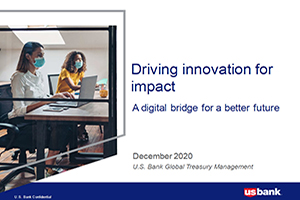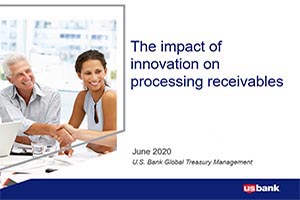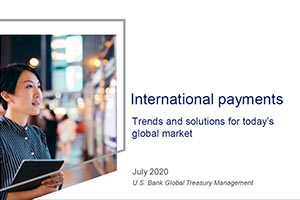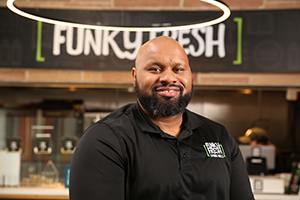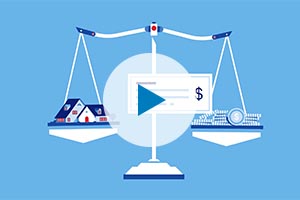Learn how voice assistants, such as Amazon’s Alexa, Google Assistant and Apple’s Siri, can help you bank from home, mobile device, vehicle and beyond.
Talking to a computer — and expecting a response — used to be a thing out of Hollywood science fiction. Now, these responsive voices go by Siri and Alexa, to name a few. More than 45 million Americans will use a smart speaker powered by a voice assistant — such as Apple’s Siri, Amazon’s Alexa or Google Assistant — in 2018, more than triple the number of users in 2016. That number is likely to grow as Americans become more comfortable with these technologies — and as their usefulness becomes more apparent.
Today, especially now that we're faced with the impacts of COVID-19, voice-assistant devices can help us bank where we are just by asking questions or giving them a command. They're most commonly used to order groceries (“Alexa, add milk to my cart”), fill us in on the latest news ("Siri, what are today's news headlines?") or keep us entertained ("Alexa, what's the joke of the day?"), but they also have the potential to be used in other ways, including personal banking. Here, we will take a look at what these devices can do, how they work and how they can make your life — and your banking — easier and safer.
Voice banking
David Marrese, senior product manager, innovation design at U.S. Bank, explains that the primary benefit of using voice-assistant technology to bank is convenience. “It makes multitasking easier,” he says.
For example, say it’s payday (or due day for your bills). If your hands aren’t free — maybe you’re getting dressed in the morning, walking your dog or making breakfast for the kids — you can simply speak into your voice-enabled device. You can ask, “Siri, did I get paid today?” and find out whether your paycheck was added to your account.
“It can make a 10-step process much easier,” Marrese says. “Rather than logging into your bank account online or through a mobile app, you can simply ask a question,” all without stopping what you’re doing.
People with accessibility needs, too, find these devices helpful. Those who are visually impaired and have trouble reading text on screen can use a voice-enabled device to have their balance read to them, transfer funds and more.
Using the U.S. Bank voice skills on your device is any easy process. “If you can set up your banking app on your phone, then you can set up your Alexa skill. It takes no more than two minutes to do,” says Marrese.
Currently, U.S. Bank customers can execute four commands with any Alexa-enabled device, such as an Amazon Echo. You can check your account balance. You can also check deposits made to your accounts and payments made from your accounts. Another useful feature is that you can ask for due dates on U.S. Bank credit cards and mortgages (“When is my credit card payment due?” for example). Finally, you can transfer funds between your U.S. Bank checking and savings accounts and make payments to your U.S. Bank credit card.
Google Assistant through Google Home allows you to do three of these commands. Marrese notes, however, that users cannot currently make credit card payments on Google Home. Siri-enabled Apple products, such as an iPhone, currently allow you to execute one command: find your account balance.
Giving voice to tech skepticism
Marrese helped develop voice-assistant technology at U.S. Bank, and he understands why many people might hesitate before using the technology. not yet widely accepted,” he says. “There are a fair amount of people who aren’t really sure what this technology is, and they’re hesitant to put a microphone in their house.”
Marrese explained that even those who consider themselves tech lovers are understandably concerned about privacy when it comes to voice assistants. “Others might be afraid of a company having access to your information,” he continues.
However, even if you’re using an Amazon, Apple, or Google voice device, these companies don’t have access to your secure financial information. “Just like your laptop doesn’t know all of the things that you're typing into it,” he continues, Alexa isn’t keeping tabs on your bank account.
Another barrier is people are often visual when it comes to their finances. It’s easier to see numbers than hear them — especially because we’re so used to checking the banking apps on our phones to see our balances. As the devices become more popular, though, Marrese thinks we’ll see a shift to more users embracing the convenience of this technology to do their banking.
Security measures
Marrese makes clear that when banking with voice-assistant technology, your financial information is as secure as it is when you use an online bank account or app.
The first layer of security comes in when you download the U.S. Bank “skill” onto your Amazon Echo, for example. “You have to enter your username and password and answer the security questions you’ve previously set up,” Marrese explains. “To complete registration, you need to set up a four-digit security code, which you speak into the device.” This ensures only you can ask Alexa for your balance. As an added security measure, Marrese says, “The skill times out after 30 seconds of inactivity.”
Marrese emphasizes that voice-assistant devices do not store your data. “Alexa, for example, doesn’t store anything. As soon as that session logs out, it’s just a black speaker in your living room.” What’s more, “If you use your smartphone app to review the transcript of everything you’ve spoken into your device, you’ll find that all account-related numbers are x’d out, so no one else can read your information.”
Voice technology 101
So how does voice-assistant technology work? If you’ve ever used one of these devices, you know they’re activated with a “wake word.” For Amazon devices, the wake word is “Alexa.” For Apple devices, it’s “Siri.” And for Google, it’s “Hey, Google.” This phrase wakes the device and initiates the device’s ability to listen for a voice command, also known as an “utterance.” Voice assistants screen out background noise and hone in on the voice making the command.
This is where it gets interesting. Marrese gives the example of speaking a command to check your account balance. “There are so many different ways you could ask that question: ‘How much money do I have? What’s my balance? How much is in my account?’” he explains. “For every possible way that we could think a customer might ask that question, we had to write it in when we were developing the skill for each device.” What seems at first like a simple command presents a dizzyingly complex programming challenge. “We counted 573 different ways a customer could ask to check their balance,” Marrese says, “and we programmed each of the variations for that utterance.”
Once the device has identified a particular utterance, it converts that command into an action that it can execute. “Programmers tell Alexa what to listen for using ‘if this, then that’ statements. If Alexa hears a statement, then she executes a given command.” In this case, if you ask for your balance, then the device will access your U.S. Bank account and speak it back to you.
All of this depends on cloud computing, which makes information available without storing it on physical servers. Marrese explains as follows: “Rather than keep all of your eggs in one basket, so to speak, you take bits and pieces of them and hide them all over the place.” When you download the U.S. Bank skill on your Alexa device, it is downloaded from the cloud. And when you ask for your balance, that info is safely pulled from secure U.S. Bank servers the same way it is when using the bank mobile app.
The future of voice banking
When you think of voice-activated devices, you probably think of your phone or an Amazon Echo or Google Home in your kitchen. But that’s just the start, as these devices move beyond the home.
According to Marrese, the digital banking initiative is “trying to bridge that gap between what’s available now and where users might be six or 12 months down the road.” He foresees a time in the near future when on-the-go voice-activated banking is as common as online banking is today. U.S. Bank is on the front lines of this trend. “Alexa, Google Assistant and Siri are the three core voice assistants, and as of today U.S. Bank is one of the first banks to use all three platforms.”
As for the future? “We’re just scratching the surface as to where we’re going with it,” Marrese says.
Learn more about voice banking at U.S. Bank and its capabilities with Alexa, Google Assistant and Siri.





























